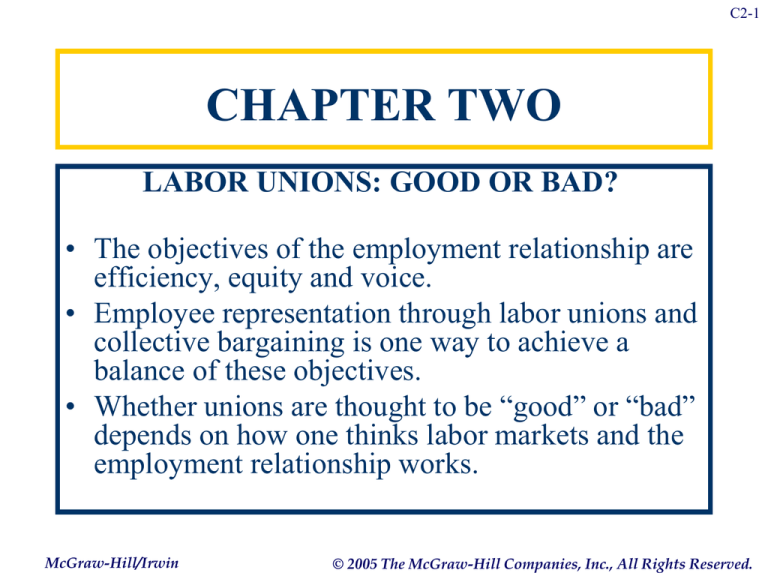
C2-1
CHAPTER TWO
LABOR UNIONS: GOOD OR BAD?
• The objectives of the employment relationship are
efficiency, equity and voice.
• Employee representation through labor unions and
collective bargaining is one way to achieve a
balance of these objectives.
• Whether unions are thought to be “good” or “bad”
depends on how one thinks labor markets and the
employment relationship works.
McGraw-Hill/Irwin
© 2005 The McGraw-Hill Companies, Inc., All Rights Reserved.
C2-2
Workplace Governance Options
Mechanism
Key Feature
Questions
Competitive Labor
Markets
Competitive markets promote efficiency
and provide protections against abuses.
Are markets competitive?
Should Ees be solely at the
mercy of markets?
Human Resource
Management
HR policies can align interests and
promote efficiency and equity.
What prevents managerial
abuses?
HRM with Voice
Employee participation in decisionmaking adds voice to HRM
Is management-controlled
voice meaningful?
Worker Control
Workers’ interests served by having them What prevents exploitation of
in control.
investors? How is efficiency
achieved?
Independent
Employee
Representation
Collective bargaining can equalize
power while involving both sides in
decision-making.
Are unions adversarial and
harmful to efficiency? What
if unions are weak or absent?
Government
Regulation
Uniform standards not dependent on the
vagaries of markets, mgmt, or power.
Do regulations stifle
efficiency?
McGraw-Hill/Irwin
© 2005 The McGraw-Hill Companies, Inc., All Rights Reserved.
C2-3
THE LABOR PROBLEM
• Neoclassical (mainstream) economics view
– Free markets and competition promote optimal (efficient) outcomes
– “Labor problem” stems from market failures or is perhaps “labor’s
situation” (unions interfere w/ markets)
• HRM view
– HR policies can align interests of Ers and Ees
– “Labor problem” would be poor mngt (unions unnecessary/conflictual)
• Industrial relations view
– Inherent conflict of interests, unequal bargaining power
– “Labor problem” stems from unequal power and lack of unions a/o gov’t
leveling of playing field (unions necessary)
• Critical view
– “Labor problem” stems from capital’s control of social institutions (unions
important mechanism, may be co-opted)
McGraw-Hill/Irwin
© 2005 The McGraw-Hill Companies, Inc., All Rights Reserved.
C2-4
THE LABOR PROBLEM
• U.S. political and legal thought during the 1800s and
1900s dominated by laissez faire views consistent with
neoclassical school of economics.
• Great Depression (1930s) called into question wisdom of
laissez faire legal and economic philosophies.
• FDR’s “New Deal” policy embraced Industrial Relations
school of thought, assumed that labor unions and collective
bargaining counter corporate bargaining power and
provide Industrial Democracy.
McGraw-Hill/Irwin
© 2005 The McGraw-Hill Companies, Inc., All Rights Reserved.
C2-5
FUNDAMENTAL ASSUMPTIONS OF HUMAN
RESOURCES AND INDUSTRIAL RELATONS
• Different possible underlying causes of labor
problems of early 20th century lead to different
views of labor unions.
• Underlying these views are four fundamental
assumptions of how markets work and nature of
employment:
• Is labor a commodity?
• Are employers and employees equals in self-regulating,
competitive labor markets?
• Is there an inherent conflict of interest between
employers and employees?
• Is employee voice important?
McGraw-Hill/Irwin
© 2005 The McGraw-Hill Companies, Inc., All Rights Reserved.
C2-6
THEORIES OF THE LABOR MOVEMENT
The several views of labor unions give rise to several
categories of theories (or views) of the labor
movement, based on social roles of labor
unions:
•
•
•
•
•
•
•
Harmful Labor Market Cartel (monopoly)
Institution for Economic Protection
Agent for Extending Industrial Democracy
Agent of Revolution
Special Interest Group in a Pluralist Society
Instrument for Achieving Psychological Needs
Agent for Moral and Spiritual Reform
McGraw-Hill/Irwin
© 2005 The McGraw-Hill Companies, Inc., All Rights Reserved.
C2-7
WHAT DO LABOR UNIONS DO?
• Are unions good or bad?
– Ultimately, no single answer to question.
– One way to address issue is through influential model
of unionism developed by economists Freeman and
Medoff.
• Model states that labor unions have two faces, a monopoly face
and a collective/institutional response face.
• With two faces, unions can have both positive and negative
effects on diverse list of workplace and societal dimensions
McGraw-Hill/Irwin
© 2005 The McGraw-Hill Companies, Inc., All Rights Reserved.
C2-8
WHAT DO UNIONS DO?
(efficiency)
Dimension
Estimated Effect of U.S. Unions
Job Satisfaction
Union workers are less satisfied (but also less
likely to quit)
Turnover
Reduced turnover
Productivity
Mixed evidence—controversial effects
Profits
Reduced profitability
McGraw-Hill/Irwin
© 2005 The McGraw-Hill Companies, Inc., All Rights Reserved.
C2-9
WHAT DO UNIONS DO?
(equity)
Dimension
Estimated Effect of U.S. Unions
Wage Levels
Higher wages (15 percent higher, on average)
Wage Distribution
Compressed (less unequal) wage structure
Benefits
Increased likelihood of benefits being offered
Just Cause Discipline Nearly universal in union contracts; rare
and Discharge
elsewhere
Public Policies
Assistance with exercising rights (e.g., workers’
compensation)
Seniority
Increased importance of seniority provisions in
personnel changes
McGraw-Hill/Irwin
© 2005 The McGraw-Hill Companies, Inc., All Rights Reserved.
C2-10
WHAT DO UNIONS DO?
(voice)
Dimension
Estimated Effect of U.S. Unions
Collective
Negotiations
Management required to bargain with certified
union
Grievance
Procedures
Nearly universal presence of formal grievance
procedures in union contracts; few nonunion
procedures with same level of due process and
representation
McGraw-Hill/Irwin
© 2005 The McGraw-Hill Companies, Inc., All Rights Reserved.
C2-11
THE LABOR PROBLEM IN THE 21ST CENTURY
• Chapter Two lays out schools of thought,
discusses historical “labor problem”
• Relevant as well for contemporary labor
relations
– Economic and social debates such as globalization
• Are modern sweatshops a problem? If so, what should be
done?
– See “Workers in Bondage”
– See www.aflcio.org
– See www.ilr.cornell.edu/trianglefire
McGraw-Hill/Irwin
© 2005 The McGraw-Hill Companies, Inc., All Rights Reserved.





